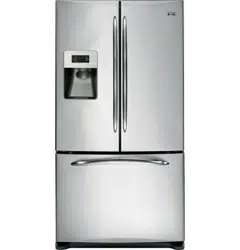Documents: Go to download!
- Owner's manual - (English, French, Spanish)
- Operating Instructions
- Care and cleaning of the refrigerator
- Installation Instructions
- Troubleshooting Tips
Table of contents
User manual Refrigerator
Operating Instructions
About the controls with temperature settings.
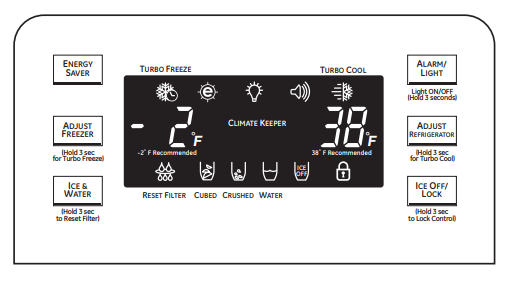
NOTE: The refrigerator is shipped with protective film covering the temperature controls. If this film was not removed during installation, remove it now
- The temperature controls are preset in the factory at 38°F for the refrigerator compartment and -2°F for the freezer compartment. Allow 24 hours for the temperature to stabilize to the preset recommended settings.
- The temperature controls can display both the SET temperature as well as the actual temperature in the refrigerator and freezer. The actual temperature may vary slightly from the SET temperature based on usage and operating environment.
Changing the Temperature
- To change the temperature, press and release the ADJUST FREEZER or ADJUST REFRIGERATOR pad. The display will show the actual temperature. To change the temperature, tap either the ADJUST FREEZER or ADJUST REFRIGERATOR pad until the desired temperature is displayed.
- Once the desired temperature has been set, the temperature display will return to the actual refrigerator and freezer temperatures after 10 seconds. Several adjustments may be required.
- Each time you adjust controls, allow 24 hours for the refrigerator to reach the temperature you have set.
About TurboCool™ and TurboFreeze.™
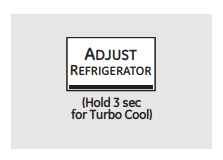
- How it Works TurboCool rapidly cools the refrigerator compartment in order to more quickly cool foods. Use TurboCool when adding a large amount of food to the refrigerator compartment, putting away foods after they have been sitting out at room temperature or when putting away warm leftovers. It can also be used if the refrigerator has been without power for an extended period.
- The compressor and fresh food fan will run immediately until the fresh food temperature cools to approximately 25°F (–4°C), maximum run time two-and-a-half hours. After reaching 25°F (–4°C), fresh food compartment will run at cold setting for one hour and return to the original setting value.
- How to Use
- Press and hold the ADJUST REFRIGERATOR pad for 3 seconds until you hear the sound and the
 displays.
displays. - After TurboCool is complete, the refrigerator compartment will return to the original setting.
- NOTES: The refrigerator temperature cannot be changed during TurboCool. The freezer temperature is not affected during TurboCool.
- Press and hold the ADJUST REFRIGERATOR pad for 3 seconds until you hear the sound and the
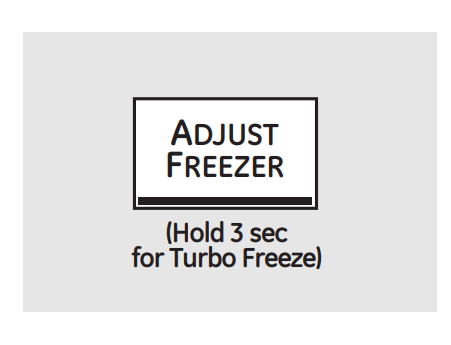
How it Works
- TurboFreeze rapidly cools the freezer compartment in order to more quickly cool foods. Use TurboFreeze when adding a large amount of food to the freezer compartment, putting away foods after they have been sitting out at room temperature or when putting away warm leftovers. It can also be used if the refrigerator has been without power for an extended period.
- The compressor and freezer fan will run immediately and keep running for two-and-a-half hours.
- How to Use
- Press and hold the ADJUST FREEZER pad for 3 seconds until you hear the sound and the
 displays.
displays. - After TurboFreeze is complete, the freezer compartment will return to the original setting.
- NOTES: The freezer temperature cannot be changed during TurboFreeze. The refrigerator temperature is not affected during TurboFreeze. When opening the freezer door during TurboFreeze, the fans will continue to run if they have cycled on.
- Press and hold the ADJUST FREEZER pad for 3 seconds until you hear the sound and the
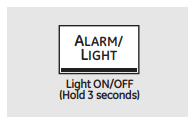
- About Door Alarm: The door alarm will sound if any door is open for more than 3 minutes. The beeping stops when you close the door.
- About Dispenser Light: Press and hold the ALARM/LIGHT pad for 3 seconds to turn on the dispenser light. To turn off, press and hold the pad again for 3 seconds.
About Energy Saver
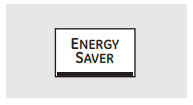
- This product is equipped with an Energy Saver feature. The refrigerator is shipped with the Energy Saver feature on.
- Over time, moisture can form on the front surface of the refrigerator cabinet and cause rust. If moisture does appear on the front surface of the refrigerator cabinet, turn off the Energy Saver feature by pressing and releasing the ENERGY SAVER pad on the control panel.
About the water filter
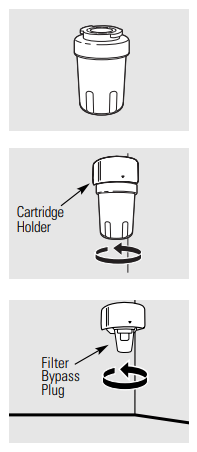
Water Filter Cartridge
- The water filter cartridge is located in the back upper right corner of the refrigerator compartment.
When to Replace the Filter
- There is a replacement indicator light for the water filter cartridge on the temperature display. This light will turn orange to tell you that you need to replace the filter soon. The filter cartridge should be replaced when the replacement indicator light turns red or if the flow of water to the dispenser or icemaker decreases.
Installing the Filter Cartridge
- If you are replacing the cartridge, first remove the old one by slowly turning it counterclockwise. A small amount of water may drip down. CAUTION: If air has been trapped in the system, the filter cartridge may be ejected as it is removed. Use caution when removing.
- Remove the protective foil from the end of the cartridge.
- Lining up the arrow on the cartridge and the cartridge holder, place the top of the new cartridge up inside the holder. Do not push it up into the holder. Slowly rotate the cartridge clockwise until it stops. As you turn the cartridge, it will automatically raise itself into position. Cartridge will rotate about 1/4 turn. Do not overtighten.
- Run water from the dispenser for 3 minutes (about 11⁄2 gallons) to clear the system and prevent sputtering. See To Use the Dispenser section.
- Press and hold the ICE & WATER pad for 3 seconds. NOTE: A newly installed water filter cartridge may cause water to spurt from the dispenser.
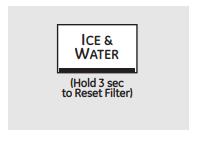
Filter Bypass Plug
- You must use the filter bypass plug when a replacement filter cartridge is not available. The icemaker will not operate without the filter or filter bypass plug
About the shelves and bins.
Rearranging the Shelves
- Shelves in the refrigerator compartment are adjustable.
Refrigerator Compartment
To remove:
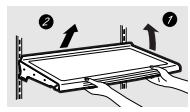
- Remove all items from the shelf.
- Tilt the shelf up at the front.
- Lift the shelf up at the back and bring the shelf out.
To replace:
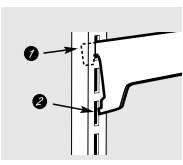
- While tilting the shelf up, insert the top hook at the back of the shelf in a slot on the track.
- Lower the front of the shelf until the bottom of the shelf locks into place.
Spillproof Shelves

- Spillproof shelves have special edges to help prevent spills from dripping to lower shelves.
Quick Space Shelf
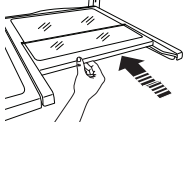
- This shelf splits in half and slides under itself for storage of tall items on the shelf below.
- This shelf can be removed and replaced or relocated (just like spillproof shelves).
About the shelves and bins
Non-Adjustable Dairy Bin
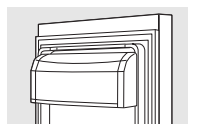
- To remove: Lift the dairy bin straight up, then pull out.
- To replace: Engage the bin in the molded door supports and push down. The bin will lock in place.
Adjustable Bins on the Door
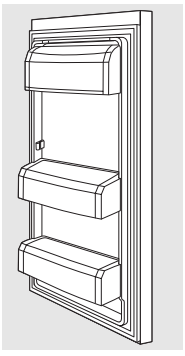
- Adjustable bins can easily be carried from refrigerator to work area.
- To remove: Lift bin straight up, then pull out.
- To replace or relocate: Slide in the bin just above the molded door supports, and push down. The bin will lock in place.
Non-Adjustable Bins on the Door
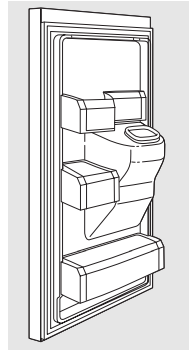
- To remove: Lift the bin straight up, then pull out.
- To replace: Engage the bin in the molded supports on the door and push down. It will lock in place.
Non-Adjustable Bin in the Freezer
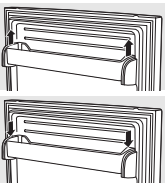
- To remove: Pull the brackets upward until you hear a clicking sound and remove the bin.
- To replace: Hook the ends of the bin into both brackets and push down until the bin locks into place.
About the crispers and pans
Fruit and Vegetable Crisper

- Excess water that may accumulate in the bottom of the drawers or under the drawers should be wiped dry
Adjustable Humidity Crisper

- Slide the control all the way to the high setting to provide high humidity recommended for most vegetables.
- Slide the control all the way to the low setting to provide lower humidity levels recommended for most fruits.
Adjustable Deli/Produce Drawer

- The Adjustable Deli/Produce Drawer is a full-width drawer with adjustable temperature control. This drawer can be used for large miscellaneous items.
- There is a temperature control which can adjust the amount of cold air allowed into the drawer.
- The control is located on the right side of the drawer.
Control
- When Produce Drawer is selected, the temperature of the drawer can be kept around 38°F (3°C). This feature also helps keep food fresh for a long time.
- When Deli Drawer is selected, the temperature of the drawer can be kept around 34°F (1°C). This feature also helps keep meat or fish fresh for a longer time.
- NOTE: Fruits and vegetables may be damaged using the Deli Drawer setting. Do not store lettuce or other leafy produce in this drawer.
- CAUTION: Do not store glass bottles in this drawer. If they are frozen, they can break and cause personal injury
How to Remove and Replace the Adjustable Deli/Produce Drawer

- To remove:
- Pull the drawer out to the stop position.
- Lift the front of the drawer up and out.
- To replace:
- Lift the cover up.
- Engage the pantry rollers into the side rails.
- Push the drawer inwards (until it is in place).
How to Remove and Replace Drawer Divider
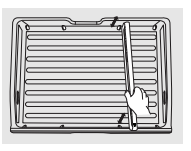
- To remove:
- Pull the drawer out to the stop position.
- Raise the front side of the divider to unhook it from the rear wall of the drawer.
- To replace:
- Hook the back of the divider over the rear wall of the drawer.
- Push the divider down.
About the freezer.
Freezer Basket and Drawer
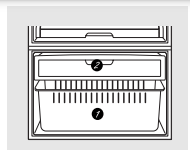
- Basket.
- Drawer.
Basket Removal
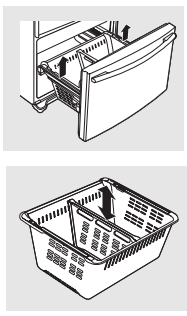
- To remove:
- Remove Freezer Bin.
- Pull basket out to the stop position.
- Tilt up the rear of the bin.
- Lift it out to remove.
- To replace:
- Place the basket into the rail assembly.
Basket Divider Removal
- To remove:
- Pull basket out to the stop position.
- Tilt up the rear of the bin.
- Lift it out to remove.
- To replace:
- Hook the top corners of the divider over the hole of the basket.
Drawer Removal
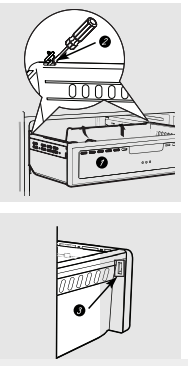
- To remove:
- Pull the drawer out to the stop position.
- Remove both side knobs with a flathead screwdriver.
- Tilt up the rear of the drawer and lift straight out.
- To replace:
- Pull both rails out to the stop position.
- Place the drawer onto the rails and hook the support into the slots located on the side of the drawer.
- Replace the side knob and push the drawer back into place.
- WARNING: Please do not lose the side knobs during disassembly since they may present a choking hazard to children.
About the automatic icemaker
A newly installed refrigerator may take 12 to 24 hours to begin making ice.
Automatic Icemaker
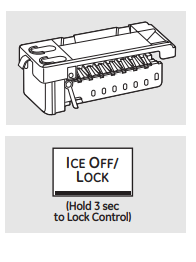
- The icemaker will produce seven cubes per cycle—approximately 100–130 cubes in a 24-hour period, depending on freezer compartment temperature, room temperature, number of door openings and other use conditions.
- If the refrigerator is operated before the water connection is made to the icemaker, turn on the ICE OFF feature by pressing and releasing the ICE OFF/LOCK pad on the control panel and the
 displays.
displays. - When the refrigerator has been connected to the water supply, turn off the ICE OFF feature by pressing and releasing the ICE OFF/LOCK pad on the control panel. The icemaker will fill with water when it cools to 15°F (–10°C). A newly installed refrigerator may take 12 to 24 hours to begin making ice cubes.
- You will hear a buzzing sound each time the icemaker fills with water.
- Throw away the first few batches of ice to allow the water line to clear.
- Be sure nothing interferes with the sweep of the feeler arm.
- When the bin fills to the level of the feeler arm, the icemaker will stop producing ice. It is normal for several cubes to be joined together.
- If ice is not used frequently, old ice cubes will become cloudy, taste stale and shrink.
- NOTE: In homes with lower-than-average water pressure, you may hear the icemaker cycle multiple times when making one batch of ice.
- NOTE: Turn on the ICE OFF feature if the water supply is shut off
To Use the Dispenser
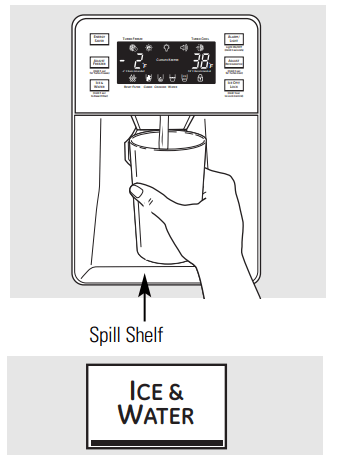
- Select CUBED
 , CRUSHED
, CRUSHED  or WATER
or WATER  by pressing the ICE & WATER pad.
by pressing the ICE & WATER pad. - Press the glass gently against the top of the dispenser cradle.
- The spill shelf is not self-draining. To reduce water spotting, the shelf should be cleaned regularly.
- If no water is dispensed when the refrigerator is first installed, there may be air in the water line system.
- Press the dispenser arm for at least two minutes to remove trapped air from the water line and to fill the water system. To flush out impurities in the water line, throw away the first six full glasses of water.
- CAUTION: Never put fingers or any other objects into the ice crusher discharge opening.
To Lock and Unlock the Dispenser

- To lock, press and hold the ICE OFF/LOCK pad for 3 seconds. Repeat this step to unlock the dispenser.
Dispenser Light

- Press and hold the ALARM/LIGHT pad for 3 seconds to turn the dispenser light on and off.
- The light also comes on when the dispenser cradle is pressed.
Important Facts About Your Dispenser
- Do not add ice from trays or bags to the storage drawer. It may not crush or dispense well.
- Avoid overfilling glass with ice and use of narrow glasses. Backed-up ice can jam the chute or cause the door in the chute to freeze shut. If ice is blocking the chute, poke it through with a wodden spoon.
- Beverages and foods should not be quick-chilled in the ice storage drawer. Cans, bottles or food packages in the storage drawer may cause the icemaker or auger to jam.
- To keep dispensed ice from missing the glass, put the glass close to, but not touching, the dispenser opening.
- Some crushed ice may be dispensed even though you selected CUBED ICE. This happens occasionally when a few cubes accidentally get directed to the crusher.
- After crushed ice is dispensed, some water may drip from the chute.
- Sometimes a small mound of snow will form on the door in the ice chute. This condition is normal and usually occurs when you have dispensed crushed ice repeatedly. The snow will eventually evaporate.
Care and cleaning of the refrigerator
Cleaning the Outside
- The door handles and trim. Clean with a cloth dampened with soapy water. Dry with a soft cloth. Do not use wax on the door handles and trim.
- Keep the outside clean. Wipe with a clean cloth lightly dampened with kitchen appliance wax or mild liquid dish detergent. Dry and polish with a clean, soft cloth. Do not wipe the refrigerator with a soiled dish cloth or wet towel. These may leave a residue that can erode the paint.
- Do not use scouring pads, powdered cleaners, bleach or cleaners containing bleach because these products can scratch and weaken the paint finish.
- The stainless steel panels and door handles. Stainless steel (on some models) can be cleaned with a commercially available stainless steel cleaner. A spray-on stainless steel cleaner works best.
- Do not use appliance wax or polish on the stainless steel.
- Silver-plated plastic parts. Wash parts with soap or other mild detergents. Wipe clean with a sponge, damp cloth or paper towel.
- Do not scrub with steel-wool pads or other abrasive cleaners
Cleaning the Inside
- To help prevent odors, leave an open box of baking soda in the refrigerator and freezer compartments.
- Unplug the refrigerator before cleaning. If this is not practical, wring excess moisture out of sponge or cloth when cleaning around switches, lights or controls.
- Use an appliance wax polish on the inside surface between the doors.
- Use warm water and baking soda solution— about a tablespoon (15 ml) of baking soda to a quart (1 liter) of water. This both cleans and neutralizes odors. Rinse and wipe dry.
- After cleaning the door gaskets, apply a thin layer of petroleum jelly to the door gaskets at the hinge side. This helps keep the gaskets from sticking and bending out of shape.
- Avoid cleaning cold glass shelves with hot water because the extreme temperature difference may cause them to break. Handle glass shelves carefully. Bumping tempered glass can cause it to shatter.
- Do not wash any plastic refrigerator parts in the dishwasher.
- Silver-accented plastic parts. Wash parts with soapy water. Wipe clean with a sponge, damp cloth or paper towel.
- Do not scrub with steel-wool pads or other abrasive cleaners.
Behind the Refrigerator
- Be careful when moving the refrigerator away from the wall. All types of floor coverings can be damaged, particularly cushioned coverings and those with embossed surfaces.
- Raise the leveling legs located at the bottom front of the refrigerator.
- Pull the refrigerator straight out and return it to position by pushing it straight in.
- Moving the refrigerator in a side direction may result in damage to the floor covering or refrigerator.
- Lower the leveling legs until they touch the floor.
- When pushing the refrigerator back, make sure you don’t roll over the power cord or icemaker supply line (on some models) and ensure the anti-tip bracket is engaged (if equipped).
Preparing for Vacation
- For long vacations or absences, remove food and unplug the refrigerator. Clean the interior with a baking soda solution of one tablespoon (15 ml) of baking soda to one quart (1 liter) of water. Leave the doors open.
- Turn on the ICE OFF feature by pressing and releasing the ICE OFF/LOCK pad on the control panel (the
 icon displays) and shut off the water supply to the refrigerator.
icon displays) and shut off the water supply to the refrigerator. - If the temperature can drop below freezing, have a qualified servicer drain the water supply system (on some models) to prevent serious property damage due to flooding
Preparing to Move
- Secure all loose items such as base grille, shelves and drawers by taping them securely in place to prevent damage.
- When using a hand truck to move the refrigerator, do not rest the front or back of the refrigerator against the hand truck. This could damage the refrigerator. Handle only from the sides of the refrigerator.
- Be sure the refrigerator stays in an upright position during moving
Replacing the light bulbs.
Refrigerator Lights

- An authorized technician will need to replace the LED light.
Freezer Light

CAUTION: Light bulbs may be hot.
- Unplug the power cord from the outlet.
- Pull drawer out to the stop position.
- Rotate the shield down while pushing it backwards to remove it.
- Turn the bulb counterclockwise.
- Replace with an appliance bulb of the same or lower wattage.
- Replace the shield.
- Plug the refrigerator back in.
NOTE: Appliance bulbs may be ordered from GE Parts and Accessories, 800.626.2002.
Installation Instructions
INSTALLING THE REFRIGERATOR
REFRIGERATOR LOCATION
- Do not install the refrigerator where the temperature will go below 60°F (16°C) because it will not run often enough to maintain proper temperatures.
- Do not install the refrigerator where the temperature will go above 100°F (37°C) because it will not perform properly.
- Install it on a floor strong enough to support it fully loaded.
CLEARANCES: Allow the following clearances for ease of installation, proper air circulation and plumbing and electrical connections.
- Sides 1/8″ (3 mm)
- Top 1″ (25 mm)
- Back 1″ (25 mm)
REMOVING THE REFRIGERATOR DOORS
- IMPORTANT NOTE: This refrigerator is 35.6″ deep. Doors and passageways leading to the installation location must be at least 36″ wide in order to leave the doors and handles attached to the refrigerator while transporting it into the installation location. If passageways are less than 36″, the refrigerator doors and handles can easily be scratched and damaged. The top cap and doors can be removed to allow the refrigerator to be safely moved indoors. Start with Step A.
- If it is not necessary to remove doors, skip Step A. Leave tape and all packaging on doors until the refrigerator is in the final location.
- NOTE: Use a padded hand truck to move this refrigerator. Place the refrigerator on the hand truck with a side against the truck. We strongly recommend that TWO PEOPLE move and complete this installation.
REMOVE THE REFRIGERATOR DOORS
- Open the refrigerator doors.
- Remove the two caps with a flat-head screwdriver.
- Remove the three screws on top with a Phillipshead screwdriver.
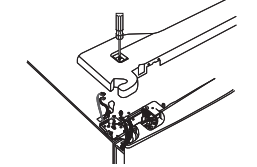
- Disengage the two electrical connectors.
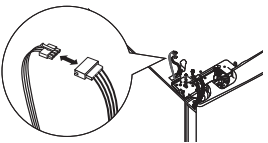
- To disconnect the water coupling, push in on the gray color of the coupling and pull out the tubing.
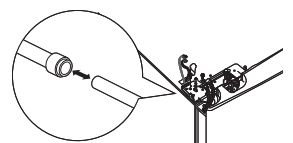
- Remove the two grounding cables with a Phillipshead screwdriver.
- Remove three 10 mm hex-head bolts (right and left)

CAUTION: When the bolts are removed, the door may fall and cause personal injury and/or damage to the door itself.
- Lift the door straight up to remove.
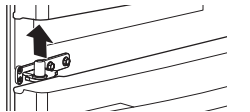
- Remove the two hex-head bolts and two Phillipshead screws from the center hinge. Set the hinge, bolts and screw aside.
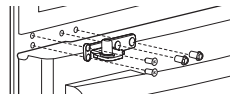
REPLACING THE REFRIGERATOR DOORS
- Install the center hinge on each side.

- Lower the refrigerator door onto the center hinge pin. Ensure that the plastic hinge pin thimble is on the center hinge pin or inside door hinge pin hole located in the bottom of the door.
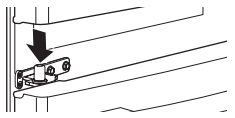
- Securely tape the door shut with masking tape or have a second person support the door.
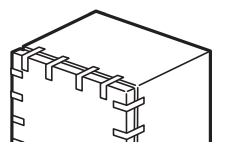
- Insert the top hinge pin into the hinge hole on top of the refrigerator door. Make sure the door is aligned with the cabinet and opposite door. Attach the hinge to the top of the cabinet. Do not tighten bolts completely.

- On left-hand doors, pass the wires and water line through the top hinge pin. Then connect the water line and two connectors. Attach the ground wire with a Phillips-head screwdriver at the right and left hinge.
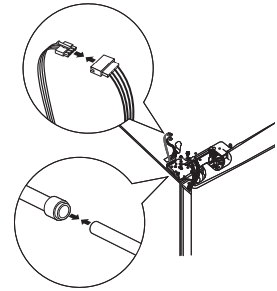
- Make sure the gasket on the door is flush against the cabinet and is not folded. Make sure the door is straight and the gap between the doors is even across the front. While holding the aligned door in place, tighten the top hinge bolts.
- Reconnect the two connectors at each side of the top cap and reattach the three Phillips-head screws on top.

REMOVE THE FREEZER DOOR
- Pull the freezer door open to full extension.
- Remove the freezer bin by pulling both brackets upward at the same time.
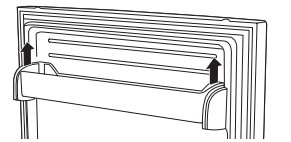
- Take out the lower basket by lifting the basket up from the rail system.
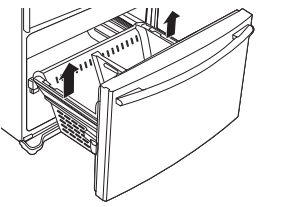
- Remove the two 10 mm hex-head bolts from the right and left side.
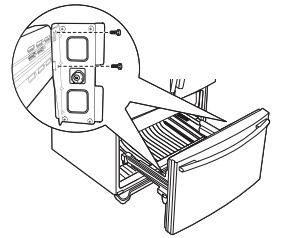
- Use the tip of a screwdriver to separate the rail from the rail cover. Tilt the front end up and lift the entire door.
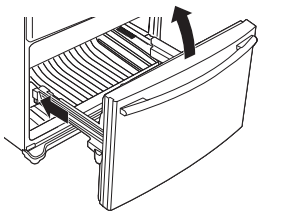
- Set the door front on a nonscratching surface.
- Push the rail assemblies back into the cabinet.
CAUTION: Push both sides of the rail assemblies back at the same time.
REPLACING THE FREEZER DOOR: Two people may be required to complete this procedure.
1. ATTACH AND SECURE THE DRAWER FRONT TO THE SLIDES
- Pull out the rail assemblies to the full length on each side of the cabinet.
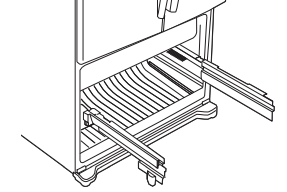
- Hang the freezer door front onto open slots on the sides.

- Tighten screws completely. (There are four 10 mm hex-head bolts.)

2. REPLACE THE FREEZER BASKET
- Replace the freezer basket by lowering it into the frame
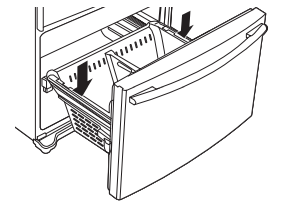
3. REPLACE THE FREEZER BIN: Hook the ends of the freezer bin into both brackets, and push down until they lock into place
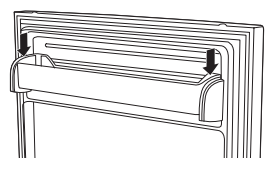
1. CONNECTING THE REFRIGERATOR TO THE HOUSE WATER LINE
(icemaker and dispenser models) A cold water supply is required for automatic icemaker operation. If there is not a cold water supply, you will need to provide one. See Installing the Water Line section.
NOTES:
- Before making the connection to the refrigerator, be sure the refrigerator power cord is not plugged into the wall outlet.
- If your refrigerator does not have a water filter, we recommend installing one if your water supply has sand or particles that could clog the screen of the refrigerator’s water valve. Install it in the water line near the refrigerator. If using GE SmartConnect™ Refrigerator Tubing Kit, you will need an additional tube (WX08X10002) to connect the filter. Do not cut plastic tube to install filter.
If you are using copper tubing, place a compression nut and ferrule (sleeve) onto the end of the tubing coming from the house cold water supply. If you are using the GE SmartConnect™ tubing, the nuts are already assembled to the tubing.
If you are using copper tubing, insert the end of the tubing into the refrigerator connection, at the back of the refrigerator, as far as possible. While holding the tubing, tighten the fitting. If you are using GE SmartConnect™ tubing, insert the molded end of the tubing into the refrigerator connection, at the back of the refrigerator, and tighten the compression nut until it is hand tight. Then tighten one additional turn with a wrench. Overtightening may cause leaks.
Fasten the tubing into the clamp provided to hold it in position. You may need to pry open the clamp.
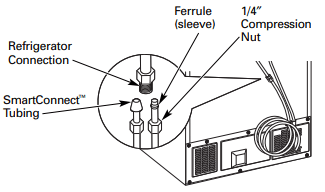
2. TURN ON THE WATER SUPPLY
- Turn the water on at the shutoff valve (house water supply) and check for any leaks.

3. PLUG IN THE REFRIGERATOR
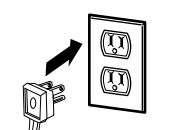
- See the grounding information attached to the power cord.
4. REMOVE THE FRESH FOOD DOOR HANDLE
- Stainless steel: A - REMOVING THE DOOR HANDLE: Loosen the set screws with the 3/32″ Allen wrench and remove the handle.
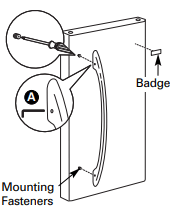
- Plastic handle: A - REMOVING THE DOOR HANDLE: Slide the handle up and off of the mounting fasteners

- NOTE: If the handle mounting fasteners need to be tightened or removed, use a Phillips-head screwdriver.
5. REMOVE THE FREEZER DOOR HANDLE
- Stainless steel and plastic handles: A - Loosen the set screws located on the underside of the handle with the 1/8″ Allen wrench and remove the handle. NOTE: If the handle mounting fasteners need to be tightened or removed, use a Phillips-head screwdriver
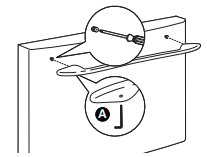
6. ATTACH THE FRESH FOOD DOOR HANDLE
Stainless steel handle:
- A - Attach the handle to the handle mounting fasteners and tighten the set screws with a 3/32″ Allen wrench.

Plastic handle:
- A - Attach the handle to the handle mounting fasteners by aligning the slots with the handle mounting fasteners.
- B - Slide it down until it is firmly locked into position.
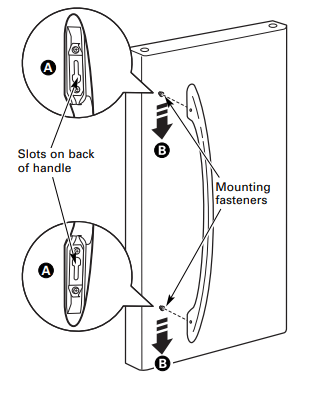
7. ATTACH THE FREEZER DOOR HANDLE
- Stainless steel and plastic handles: A - Attach the handle firmly to the mounting fasteners and tighten the set screws on the bottom of the handle with a 1/8″ Allen wrench.
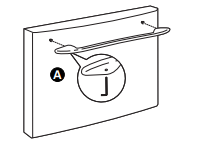
8. LEVEL THE REFRIGERATOR - The leveling legs have 2 purposes:
- Leveling legs adjust so the refrigerator is firmly positioned on the floor and does not wobble.
- Leveling legs serve as a stabilizing brake to hold the refrigerator securely in position during operation and cleaning. The leveling legs also prevent the refrigerator from tipping.
A- Turn the leveling legs clockwise to raise the refrigerator, counterclockwise to lower it.

9. LEVEL THE REFRIGERATOR DOORS: Remember a level refrigerator is necessary for getting the doors perfectly even. If you need help, review the previous section on leveling the refrigerator
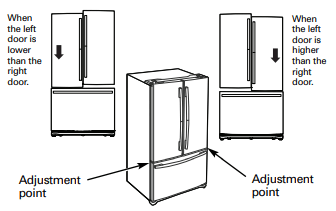
- If you open the freezer door, you can see the center hinge.
- Insert the supplied 4 mm Allen wrench into the shaft of the center hinge.
- Adjust the height by turning clockwise or counterclockwise. When you turn counterclockwise, the door will move up.
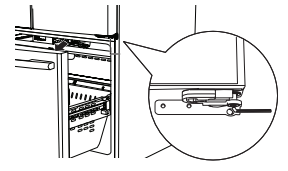
- After adjusting the doors, please insert the supplied fastener ring using a pair of pliers in the gap between the hinge grommet and the center hinge. The number of fastener rings you will need to insert depends on the gap.
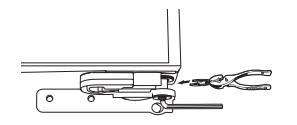
10. LEVEL THE FREEZER DOOR
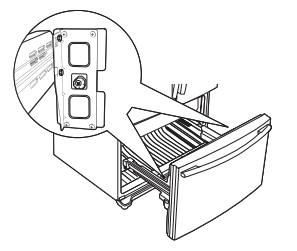
- Locate the height adjuster in the freezer door. Slightly loosen the four Phillipshead screws from the door on each side (right and left).
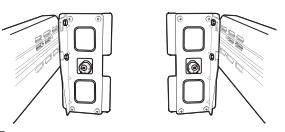
- Loosen the controller screw with a Phillips-head screwdriver to adjust the level.
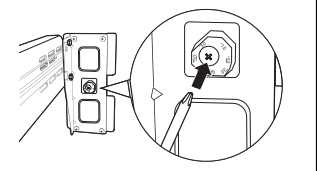
- Find the best position to align the door slope.
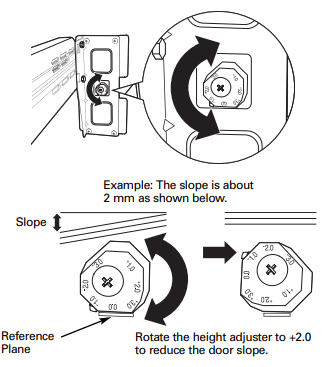
- After adjustment, tighten all the screws.
11. SET THE CONTROLS: Set the controls to the recommended setting
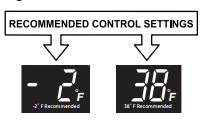
12. REMOVE PACKAGING
- A) Remove all tape, foam and protective packing from shelves and drawers. The icemaker will not begin to operate until it reaches its operating temperature of 15°F (–9°C) or below. It will then begin operation automatically. It will take 2–3 days to fill the ice bin.
Troubleshooting Tips
Normal operating sounds
Newer refrigerators sound different from older refrigerators. Modern refrigerators have more features and use newer technology
Do you hear what I hear? These sounds are normal.

- The new high efficiency compressor may run faster and longer than your old refrigerator and you may hear a high-pitched hum or pulsating sound while it is operating.
- You may hear a whooshing sound when the doors close. This is due to pressure equalizing within the refrigerator.

- You may hear the fans spinning at high speeds. This happens when the refrigerator is first plugged in, when the doors are opened frequently or when a large amount of food is added to the refrigerator or freezer compartments. The fans are helping to maintain the correct temperatures.
- The fans change speeds in order to provide optimal cooling and energy savings.

- You may hear cracking or popping sounds when the refrigerator is first plugged in. This happens as the refrigerator cools to the correct temperature.
- The freezer control will click when starting or stopping the compressor.
- Expansion and contraction of cooling coils during and after defrost can cause a cracking or popping sound.
- On models with an icemaker, after an icemaking cycle, you may hear the ice cubes dropping into the ice bucket.
- On models with a dispenser, during water dispense, you may hear the water lines move at initial dispense and after dispenser button is released.

- The flow of refrigerant through the freezer cooling coils may make a gurgling noise like boiling water.
- Water dropping on the defrost heater can cause a sizzling, popping or buzzing sound during the defrost cycle.
- A water dripping noise may occur during the defrost cycle as ice melts from the evaporator and flows into the drain pan.
- Closing the door may cause a gurgling sound due to pressure equalization.
Before you call for service…
1. Refrigerator does not operate
- Refrigerator in defrost cycle.
- Wait about 30 minutes for defrost cycle to end.
- Refrigerator is unplugged.
- Push the plug completely into the outlet.
- The fuse is blown/circuit breaker is tripped.
- Replace fuse or reset the breaker.
2. Vibration or rattling slight vibration is normal)
- Leveling legs need adjusting.
- See Level the Refrigerator
3. Motor operates for long periods or cycles on and off frequently (Modern refrigerators with more storage space and a larger freezer require more operating time. They start and stop often to maintain even temperatures.)
- Normal when refrigerator is first plugged in.
- Wait 24 hours for the refrigerator to completely cool down.
- Often occurs when large amounts of food are placed in refrigerator
- This is normal.
- Door left open.
- Check to see if package is holding door open.
- Hot weather or frequent door openings.
- This is normal.
- Temperature control set at the coldest setting.
- See About the controls
- TurboCool function has been activated
- This is normal when the TurboCool function is activated. See About TurboCool for more information.
4. Refrigerator or freezer compartment too warm
- Temperature controls not set cold enough.
- See About the controls.
- Warm weather or frequents door openings.
- Set the temperature control one step colder. See About the controls.
- Door left open.
- Check to see if package is holding door open.
5. Frost or ice crystals on frozen food (frost within package is normal)
- Door left open.
- Check to see if package is holding door open.
- Door openings too frequent or too long
6. Frequent “buzzing” sound
- ICE OFF feature is turned off, but the water supply to the refrigerator has not been connected.
- Press and release the ICE OFF/LOCK pad on the control panel to turn on the ICE OFF feature, and then the
 icon will be displayed. Keeping the ICE OFF feature on will damage the water valve.
icon will be displayed. Keeping the ICE OFF feature on will damage the water valve.
- Press and release the ICE OFF/LOCK pad on the control panel to turn on the ICE OFF feature, and then the
7. Small or hollow cubes
- Water filter clogged.
- Replace filter cartridge with new cartridge or with plug
8. Automatic icemaker does not work
- ICE OFF feature is turned on.
- Press and release the ICE OFF/LOCK pad on the control panel to turn off the ICE OFF feature, and then the
 icon will disappear.
icon will disappear.
- Press and release the ICE OFF/LOCK pad on the control panel to turn off the ICE OFF feature, and then the
- Water supply turned off or not connected.
- See Installing the water line.
- Freezer compartment too warm.
- Wait 24 hours for the refrigerator to completely cool down.
- Piled up cubes in the storage bin cause the icemaker to shut off
- Level cubes by hand.
- Ice cubes stuck in icemaker.
- Turn off the icemaker, remove cubes and turn the icemaker back on.
9. Ice cubes have odor/taste
- Food transmitting odor/tast to ice cubes.
- Wrap foods well.
- Interior of refrigerator needs cleaning
- See Care and cleaning.
- Keep an open box of baking soda in the refrigerator; replace every three months.
10. Slow ice cube freezing
- Door left open.
- Check to see if package is holding door open
- Freezer control not set cold enough.
- See About the controls.
11. Refrigerator has odor
- Foods transmitting odor to refrigerator.
- Foods with strong odors should be tightly wrapped.
- Keep an open box of baking soda in the refrigerator; replace every three months.
- Interior needs cleaning.
- See Care and cleaning.
12. Moisture forms on outside of refrigerator
- Not unusual during periods of high humidity.
- Wipe surface dry and reset the refrigerator control one setting colder.
- Turn off Energy Saver mode
13. Moisture collects inside (in humid weather, air carries moisture into refrigerator when doors are opened)
- Too frequent or too long door openings.
14. Refrigerator or freezer compartment light does not work
- No power at outlet.
- Replace fuse or reset the breaker
- Light bulb burned out or loose
- See Replacing the light bulbs.
15. Door/drawer does not close by itself
- Leveling legs need adjusting.
- See Installing the Refrigerator.
16. Hot air from bottom of refrigerator
- Normal air flow cooling motor. In the refrigeration process, it is normal that heat be expelled in the area under the refrigerator. Some floor coverings will discolor at these normal and safe temperatures.
17. Food freezing in the refrigerator
- Food too close to the air vent at the back of the refrigerator.
- Move the food away from the air vent.
- Refrigerator control is set too cold.
- Move the refrigerator control to a warmer temperature setting one increment at a time.
18. Water has poor taste/odor
- Water dispenser has not been used for a long time.
- Dispense water until all water in system is replenished.
19. Water in first glass is warm
- Normal when refrigerator is first installed.
- Wait 24 hours for the refrigerator to completely cool down
- Water dispenser has not been used for a long time.
- Dispense water until all water is system is replenished.
- Water system has been drained.
- Allow several hours for replenished supply to chill.
20. Water dispenser does not work
- Water supply line turned off or not connected.
- See Installing the water line.
- Water filter clogged.
- Replace filter cartridge or remove filter and install plug
- Air may be trapped in the water system
- Press the dispenser arm for at least 2 minutes.
- Water in reservoir is frozen because the controls are set too cold.
- Set the refrigerator control to a warmer setting and wait 24 hours. If water does not dispense after 24 hours, call for service.
21. Water spurting from dispenser
- Newly installed filter cartridge.
- Run water from the dispenser for 3 minutes (about 11⁄2 gallons).
22. No water or ice cube production
- Supply line or shutoff valve is clogged.
- Call a plumber
- Water filter clogged
- Replace filter cartridge or remove filter and install plug
- Filter cartridge not properly installed.
- Remove and reinstall filter cartridge, being certain that it locks into place. The blade on the end of the cartridge should be positioned vertically
23. Water is leaking from dispenser
- Glass not being held under the dispenser long enough after button is released.
- Hold the glass underneath the dispenser for 2–3 seconds after releasing the dispenser button. Water may continue to dispense after the button is released.
- Air may be present in the water line system, causing water to drip after being dispensed.
- Dispense water for at least 2 minutes to remove air from system.
24. Water filter indicator light changed color
- This is normal.
- See About the water filter for more information.
25. Water filter indicator light remains red even after replacing the water filter
- Water filter indicator must be reset.
- Press and hold the ICE & WATER pad for 3 seconds. See About the water filter for more information.
26. Water filter indicator light is not lit
- This is normal. This light will turn orange to tell you that you need to replace the filter soon. The filter cartridge should be replaced when the replacement indicator light turns red.
- See About the water filter for more information.
27. Handle is loose / handle has a gap
- Handle needs adjusting
- See Attach the Fresh Food handle and Attach the Freezer handle sections for detailed instructions.
28. Refrigerator beeping
- This is the door alarm.
- Close door.
29. Control setting is not lit
- On some models, the light bulbs at the top of the refrigerator compartment light up the temperature control settings
- If the control settings do not light up, check to see if the light bulbs are burned out, and replace if necessary
See other models: GDT580SSF2SS GTS18JBPMRCC JGB902WEH3WW CTX14CIBHRWW HDA3230Z05WW
